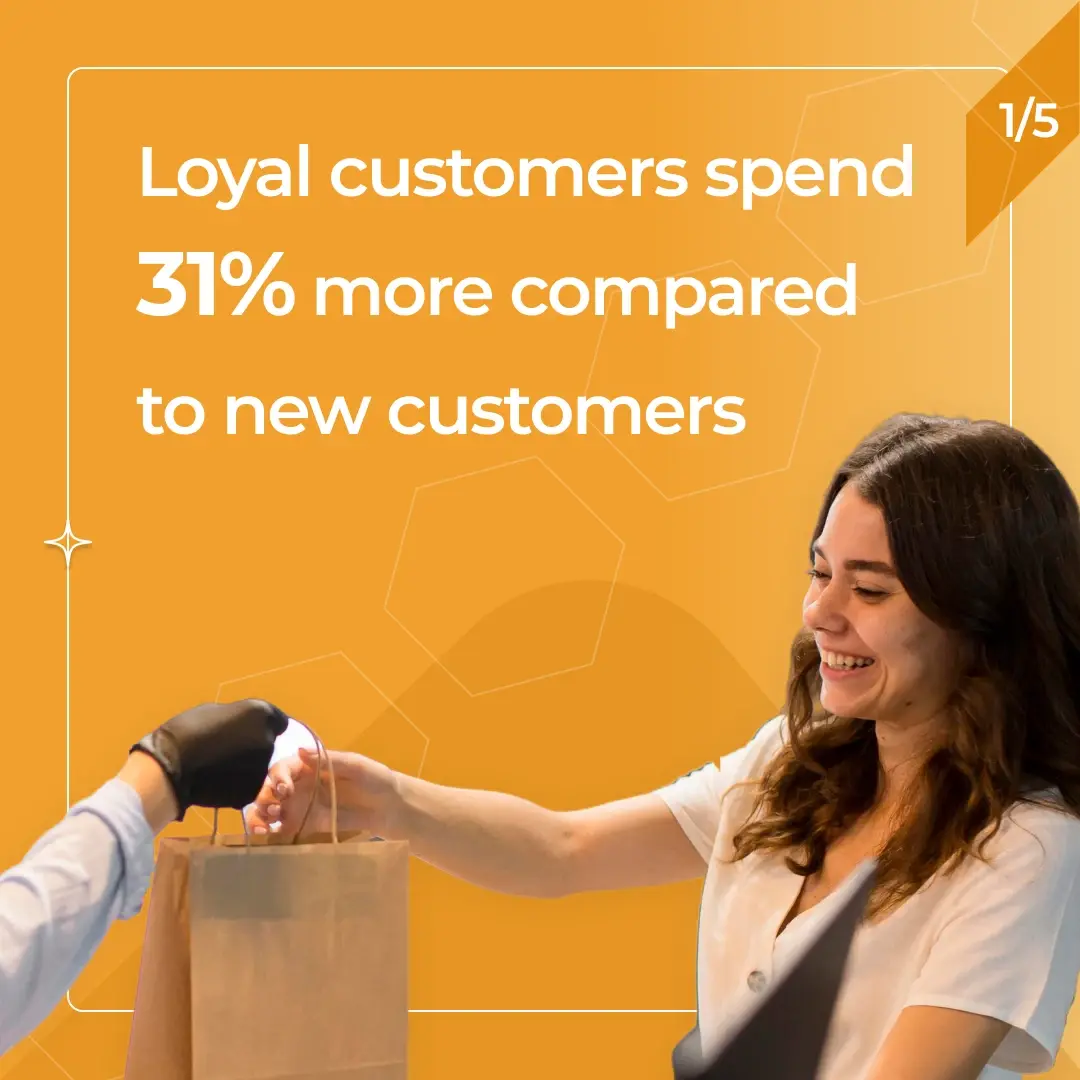
When you’re a few points away from receiving a free cup of coffee, have you ever noticed yourself returning to the same coffee shop? Or may your loyalty to a specific airline stem from the miles you’ve accrued?
That is how loyalty programs work their magic. Retaining clients is more important than ever in today’s cutthroat economy. loyalty program benefits have several positive effects; they guarantee customer retention and give them a sense of worth and appreciation.
Customer loyalty programs foster a sense of community and encourage consumers to pick your company over competitors by providing incentives and prizes. Let’s explore the many types of loyalty programs, their definitions, and above all the advantages they can offer your company.
What is a Loyalty Program?
In its most basic form, a loyalty program is a structured marketing approach created to persuade consumers to keep using the products or services of a company affiliated with the program. It honors devoted clients who interact with a brand regularly. These benefits can take many forms, including points, exclusive access to new products, discounts, and freebies.
For example, imagine a coffee shop that has a loyalty card. Each time you buy a coffee, they stamp your card. After ten stamps, you get a free coffee. This encourages you to keep coming back to that same coffee shop because you know you’ll eventually get a reward. In simple terms, a loyalty program is like a thank-you from a company to its customers for choosing them over and over again.

10 Benefits of Loyalty Program
Now that we know what loyalty programs are and the different types available, let’s explore the benefits of loyalty programs for your business.
- A higher Rate of Customer Retention
A significant advantage of loyalty program benefits is a rise in client retention. Maintaining current clientele is less expensive than bringing in new ones. You can encourage clients to stay longer by offering them a prize for their continued business.
- Increased Income and Sales
Revenue and sales might rise as a result of loyalty program. Customers are more likely to make more purchases to meet their objectives when they are on the verge of receiving a reward. Higher average order values and more frequent purchases may follow from this.
- Increased Contentment with Clientele
Customers are happy when they feel that they are valued and appreciated. By demonstrating your appreciation for their business, loyalty programs can boost consumer satisfaction and generate favorable evaluations.
- Improved Customer Knowledge
loyalty program yield useful information about the preferences and behavior of customers. You may better serve your clients' demands by customizing your product offers and marketing methods with the use of this information.
- An Edge Over Competitors
A loyalty program might help you stand out from the competition. When consumers are forced to pick between your company and another, a well-thought-out loyalty program may be the thing that convinces them to select you.
- Marketing Cost-Efficiency
Programs for loyalty are an affordable marketing tactic. You can invest in rewarding your devoted clients instead of shelling out big bucks for traditional advertising, which can result in word-of-mouth recommendations and organic development.
- Enhanced Customer Lifetime Value
Programs for loyalty can greatly increase a customer's lifetime value. Customers are more likely to stick with your brand over time and spend more money overall with you when they feel appreciated and rewarded for their ongoing business.
- Better Customer Engagement
loyalty program promote continued communication between your company and its clients. Customers are more likely to interact with your business frequently when you offer them incentives like points, rewards, and exclusive promotions. This build brand loyalty and fosters a deeper emotional bond.
- More Effective Cross-Selling and Upselling
You may determine the preferences and purchasing patterns of your customers by using the data collected from loyalty program . By properly cross-selling and upselling products that match their interests, you may increase sales and improve the customer experience with the help of this information.
- Improved Customer Advocacy
Customers who are pleased and satisfied with your business are more inclined to recommend it. They can create a network of devoted customers and enhance the reputation of your brand by recommending friends and family, leaving favorable reviews, and spreading good word-of-mouth about your company.
Types of Loyalty Programs
The four
types of loyalty programs and the benefits of each There are four main types of loyalty programs point-based, value based, tiered, and subscription-based. Each has its own pros and cons.
- Programs with a point system
- How it operates: When customers make purchases, they accrue points. They can utilize these points at a later time to receive deals or prizes.
For example, every dollar spent through Sephora’s Beauty Insider program earns points that may be redeemed for deals or premium merchandise.
- Benefits: Simple to join and comprehend. Consumers are aware of the requirements for earning incentives. However, if it takes too long to receive valuable benefits, customers can become disinterested.
- Value-based Programs
- How it works: In addition to being based on sales, rewards are also given for acts that advance the brand, such as social media shares and referrals.
MoxieLash, for instance, offers prizes to consumers who follow them on Instagram and make purchases.
- Benefits: Encouraging engagement beyond sales, strengthens relationships with customers. Rewards are in line with the ideals of the brand.
- Tiered Programs
- How it works: When customers spend more money or interact with the brand more, they are rewarded according to their membership level.
Example: As clients spend more, Astrid & Miyu’s loyalty program gives tiers with ever more perks.
- Advantages: Promotes increased expenditure and recurring business. Benefits must be compelling enough to encourage users to advance, yet overseeing several stages might be challenging.
- Subscription-based Programs
- How it operates: Participants can pay a one-time or recurring fee to have access to exclusive advantages.
Example: Free delivery and streaming services are among the perks of Amazon Prime, but there is an annual cost.
- Benefits: Produces consistent revenue and gives clients exceptional treatment through unique benefits. However, the upfront expense can turn off certain clients thereforetherefore, to keep subscribers, the advantages must outweigh the cost.

Creating a Customer Loyalty Program
Build a customer loyalty program involves several key steps to meet business goals and customer expectations. Here’s a simple guide to help you develop an effective loyalty program:
- Different Types of Different Industries
- Retail: Points-based schemes work well for regular purchases. Customers accrue points that can be exchanged for incentives or savings with every purchase. Beauty Insider at Sephora is one example.
- Hotels and Airlines: High-value clients can be effectively rewarded through tiered schemes. Better prizes are offered at higher stages, which encourage further participation and expenditure.
- Low-Frequency Purchases: Referral rewards work better for things with longer buy cycles, including pricey home appliances. Customers are encouraged to recommend friends and family through these initiatives.
- Identifying the Problem
Determine the precise issues your loyalty program seeks to address before creating it. Increased average order value, client retention, or improved consumer involvement are a few advantages. Organize your program to meet these requirements. For instance, provide awards that are dependent on the total amount spent rather than the quantity of purchases if you want to raise the average order value.
- Understanding Your Customers
The key to a successful loyalty program is knowing what your customers want and need. Find out if they are interested in special offers, free shipping, or early access to products. To obtain information, do focus groups, surveys, or customer interviews.
- Company Size and Resources
- Big Businesses: Possess the means to put complex, multi-tiered programs into place.
- Small Businesses: May favor point-based systems or other simpler, easier-to-manage platforms. These programs can provide clients with substantial value, leveling the playing field with larger competitors.
- When to Implement
Once you have a clientele, you should think about launching a loyalty program, but don't rush it. Build the program from the ground up, starting simply. Make sure you have the tools necessary to run the software efficiently.
- Loyalty Program Software
Choose software based on your business size, program complexity, and budget. Consider:
- Implementation: How will the application work with the systems you already have in place?
- Communication: How are you going to advertise the program and stay in touch with participants? Tools are useful for communication automation.
- Analytics: What kind of analysis will you do with the program's generated data? Programs like LoyaltyLion facilitate communications, setup, performance measurement, and referral linkages.
By considering these factors, you can create a customer loyalty program that rewards your customers and drives long-term business success.

The Key Metrics to Measure the Success of your Loyalty Program
To know if your loyalty program is working, consider these important metrics:
- Average Order Value (AOV)
- Definition: The average amount a customer spends per transaction.
- Calculation: Divide total revenue by the number of orders.
- Formula: AOV = Total Revenue / Number of Orders
- Indicator: An increase suggests customers are spending more due to the program.
- Purchase Frequency (PF)
- Definition: How often customers make purchases.
- Calculation: Divide the total number of purchases by the number of unique customers over a set period.
- Formula: PF = Total Number of Purchases / Number of Unique Customers.
- Indicator: Higher purchase frequency indicates successful customer engagement.
- Customer Lifetime Value (CLV)
- Definition: The total revenue expected from a customer throughout their relationship with your business.
- Calculation: Multiply average purchase value, purchase frequency, and average customer lifespan.
- Simplified Formula: CLV = Average Purchase Value x Purchase Frequency x Average Customer Lifespan.
- Indicator: Higher CLV for loyalty program members shows effectiveness.
- Revenue and New Customers from Word of Mouth
- Definition: Revenue generated from referrals by existing customers.
- Calculation: Multiply the number of referred customers by the average purchase value.
- Formula: Word of Mouth Revenue = Number of Referred Customers x Average Purchase Value.
- Indicator: Increased referrals mean effective brand advocacy.
- Redemption Rates
- Definition: The percentage of rewards earned that customers redeem.
- Calculation: Divide the number of rewards redeemed by the number of rewards earned, then multiply by 100 for a percentage.
- Formula: Redemption Rate (%) = (Number of Rewards Redeemed / Number of Rewards Earned) x 100
- Indicator: Low redemption rates suggest unattractive rewards or a complicated redemption process.
- Program Engagement
- Definition: The level of customer interaction with the loyalty program.
- Calculation: Divide the number of active customers by the total number of customers, then multiply by 100 for a percentage.
- Formula: Program Engagement (%) = (Number of Active Customers / Total Number of Customers) x 100
- Indicator: High engagement reflects program value and customerb satisfaction.
- Customer Churn Rate
- Definition: The percentage of customers who stop buying from you within a specific period.
- Calculation: Subtract the number of customers at the end of the period from the number at the start, divide by the number at the start, and multiply by 100 for a percentage.
- Formula: Churn Rate (%) = (Number of Customers at Start – Number of Customers at End) / Number of Customers at Start x 100
- Indicator: A decreasing churn rate suggests better customer retention.
By regularly monitoring these metrics, you can gauge the effectiveness of your loyalty program and make necessary adjustments to enhance its performance.

Why Choose 99minds
When it comes to creating an effective loyalty program, choosing the right platform is crucial. Here’s why
99minds stands out as the optimal choice for your business:
- Comprehensive and Customizable Solutions
Numerousloyalty programoptions are available from 99minds, all of which may be customized to meet the particular requirements of your company. 99minds has the adaptability to design a program that works for you, whether you are a large organization in need of a multi-tiered program or a small firm looking for a straightforward points-based system.
- User-Friendly Interface
Our platform is made to be as simple to use as possible. Your loyalty program can be set up and run without the need for an IT specialist. You can easily build, manage, and oversee your loyalty programs thanks to the user-friendly interface.
- Advanced Analytics and Insights
Improving your loyalty plan requires an understanding of your consumers' behavior. Robust analytics tools from 99minds enable an in-depth understanding of consumer behavior, interests, and engagement. Your decision-making to increase the efficacy of your program is aided by this data.
- Seamless Integration
99minds ensures a hassle-free setup by seamlessly integrating with your current platforms and systems. The switch to a loyalty program is easy because our solutions work with a variety of POS systems, marketing tools, and e-commerce platforms.
- Personalized Customer Engagement
99minds ensures a hassle-free setup by seamlessly integrating with your current platforms and systems. The switch to a loyalty program is easy because our solutions work with a variety of POS systems, marketing tools, and e-commerce platforms.
- Real-Time Reward Management
With real-time updates and reminders regarding their reward status, you can keep your clients interested. With 99minds, you can dynamically manage rewards and make sure that your customers are always aware of your brand and encouraged to interact with it.
- Scalable Solutions
Your loyalty program has the potential to expand along with your business. Long-term success is ensured by 99minds' scalable solutions, which can adjust to your changing business needs and growing customer base.
- Dedicated Support Team
Our committed support staff is available to help you with any questions or difficulties at any time. We offer constant support to guarantee the seamless operation of your loyalty program, from initial setup to ongoing maintenance.
- Innovative Features
With 99minds' cutting-edge features, you can stay one step ahead of the competition. Our platform provides a range of options, such as social media integration and gamification aspects, to keep your loyalty program interesting and engaging.
- Cost-Effective Solutions
We provide affordable pricing options that provide you with a great return on your investment. You can create a top-notch loyalty program without going over budget by using 99minds.
By choosing
99minds, you are partnering with a platform that is dedicated to helping you build lasting relationships with your customers. Our commitment to innovation, customization, and customer satisfaction makes us the ideal choice for businesses looking to implement a successful loyalty program.

Conclusion
To sum up, loyalty programs are an effective tool for companies looking to boost sales, keep consumers, and raise customer satisfaction levels. You can customize a
loyalty program that fits your customer base's tastes and your business goals by learning about the different kinds of loyalty programs and their benefits. With the help of
99minds, you can design and implement a tailored
loyalty program that meets your unique needs.
In the future, keeping up with new developments in loyalty program tactics will be essential to making sure your program stays current and keeps producing positive outcomes. By taking a proactive stance, you may maintain your competitive advantage and cultivate enduring client loyalty.
Frequently Ask Questions (FAQs)
How can businesses benefit from implementing a loyalty program?
Loyalty programs benefit businesses by increasing customer retention, boosting sales, and gathering valuable customer data for personalized marketing.
What are some common types of loyalty programs that businesses can implement?
Common types include points-based programs (earn points for rewards), tiered programs (unlock benefits as you spend more), and cashback programs (get money back on purchases).
How can loyalty programs evolve to stay relevant in the future?
hey can evolve by personalizing rewards based on customer behavior, integrating rewards across online and offline channels, and incorporating social and environmental responsibility into their incenti 


